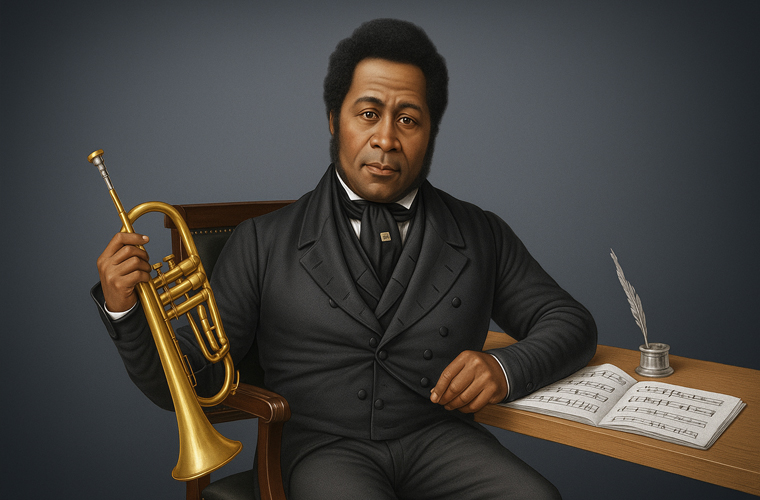Francis “Frank” Johnson (1792–1844) was a trailblazing African American musician, composer, and bandleader whose innovative work bridged the worlds of military marches, society dances, and sacred music in early 19th-century America. As one of the first Black composers to achieve widespread acclaim, Johnson defied racial barriers to become a fixture in Philadelphia’s cultural scene, influencing generations of American musicians and foreshadowing elements of jazz and ragtime in his rhythmic improvisations and programmatic compositions.
Born on June 16, 1792, in Martinique in the West Indies, Johnson grew up amid the vibrant sounds of Caribbean folk traditions and colonial influences that would later infuse his music with unique flair. At the age of 17, in 1809, he emigrated to Philadelphia, Pennsylvania—a bustling hub of free Black intellectual and artistic life in the young United States. While some historical accounts debate his birthplace, suggesting Philadelphia as an alternative based on baptism records there, the narrative of his West Indian origins aligns with family lore and underscores his transatlantic roots. Little is documented about his childhood training, but by his early 20s, Johnson had immersed himself in Philadelphia’s musical underworld, honing skills on the violin, keyed bugle (a valved brass instrument he mastered as a virtuoso), flute, and piano. He likely drew early instruction from Irish immigrant Richard Willis, a bandleader who later headed the West Point Military Academy ensemble.
Johnson’s professional debut came around 1812, when he emerged as a sought-after violinist for local balls, parades, and dancing schools. In an era of entrenched segregation, he initially led an all-Black ensemble catering to Philadelphia’s free Black community, performing at events like church services and social gatherings. His breakthrough arrived in 1818 with the publication of Johnson’s Collection of New Cotillions by George Willig, marking him as the first African American composer to have original sheet music printed—a milestone that opened doors to white patronage despite rampant discrimination.
By the 1820s, Johnson’s band had ballooned in reputation, rivaling white ensembles and securing gigs for elite white socialites at lavish cotillions and quadrilles. He composed over 200 pieces, blending European forms like waltzes and marches with African diasporic rhythms, patriotic themes, and innovative sound effects. Standout works included New Cotillions and March (1824), performed for Revolutionary War hero Marquis de Lafayette during his U.S. tour; Bird Waltz, featuring flute obbligatos mimicking canary chirps; and Philadelphia Fireman’s Quadrille, where his bugle evocatively “cried” “Fire! Fire!” His arrangements, such as a vivid rendition of František Kotzwara’s The Battle of Prague, complete with battle noises, and New Railroad Gallop evoking steam engine chugs, showcased his flair for program music—narrative-driven scores that painted vivid scenes.
Johnson’s studio at 65 South 4th Street (later near 11th and Lombard) became a hub of musical education, where he taught both Black and white students amid walls lined with instruments and thousands of scores. His economic success placed him in Philadelphia’s upper-middle class, a rarity for Black artists of the time. He also contributed to sacred music, staging grand performances like Haydn’s The Creation at Philadelphia’s First African Presbyterian Church in 1841—the first such oratorio by a Black ensemble in the U.S.
Johnson’s innovations extended beyond composition: he pioneered racially integrated concerts in the U.S., mentored emerging Black musicians (including his brother-in-law William Appo), and led the “Philadelphia School” of composers—the nation’s first such collective. In 1837, at age 45, he achieved a historic coup by taking a small all-Black ensemble to England for Queen Victoria’s coronation celebrations, becoming the first American musical group to tour Europe and the first Black bandleader to perform abroad. Thrilling audiences at Buckingham Palace, Johnson impressed the young queen, who gifted him a silver bugle in 1838—a symbol of royal endorsement. Back in Philadelphia, he introduced the “promenade concert” format (precursor to modern pops concerts) and Strauss waltzes, while touring domestically from Toronto to St. Louis.
Yet success came amid adversity: Johnson faced racist expulsions (like in St. Louis), violent harassment in Pittsburgh, and skepticism from white critics doubting his literacy in music notation. Undeterred, his works like The Grave of the Slave and Recognition March on the Independence of Haiti wove abolitionist sentiments into melody, reflecting his commitment to equality. He provided music for University of Pennsylvania events, including School of Medicine commencements from 1826 to 1841, cementing his ties to the city’s institutions.
In his final years, Johnson continued leading his band—now interracial—for milestones like Charles Dickens’ U.S. visit and George Washington’s centennial. He married Helen Appo, sister of bandmate William Appo, though details of their union remain sparse. Tragically, he died on April 6, 1844, in Philadelphia at age 51, likely from cholera or related illness during an epidemic. His ensemble persisted for two decades under successors like Joseph Anderson Sr., preserving his arrangements.
Johnson’s legacy endures as a forefather of American music. His improvisational techniques—singing while playing, extended harmonies, and rhythmic freedoms—anticipated jazz, while his global reach and barrier-breaking feats inspired later figures like Scott Joplin and Duke Ellington. Revived in the late 20th century, his scores appear on modern recordings, reminding us of a man who, from Martinique’s shores to Europe’s courts, composed not just notes, but a soundtrack for freedom.

